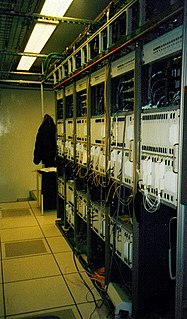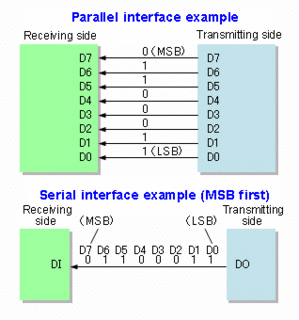
Asynchronous Transfer Mode (ATM) is a telecommunications standard defined by ANSI and ITU standards for carriage of user traffic, including telephony (voice), data, and video signals. ATM was developed to meet the needs of the Broadband Integrated Services Digital Network, as defined in the late 1980s, and designed to integrate telecommunication networks. Additionally, it was designed for networks that must handle both traditional high-throughput data traffic and real-time, low-latency content such as voice and video. The ATM network reference model approximately maps to the three lowest layers of the ISO-OSI reference model: physical layer, data link layer, and network layer. ATM is a core protocol used in the SONET/SDH backbone of the public switched telephone network (PSTN) and in the Integrated Services Digital Network (ISDN), but has largely been superseded in favor of next-generation networks based in Internet Protocol (IP) technology, while wireless and mobile ATM never established a significant foothold.

Synchronous optical networking (SONET) and synchronous digital hierarchy (SDH) are standardized protocols that transfer multiple digital bit streams synchronously over optical fiber using lasers or highly coherent light from light-emitting diodes (LEDs). At low transmission rates data can also be transferred via an electrical interface. The method was developed to replace the plesiochronous digital hierarchy (PDH) system for transporting large amounts of telephone calls and data traffic over the same fiber without the problems of synchronization.
In the seven-layer OSI model of computer networking, the physical layer or layer 1 is the first and lowest layer. This layer may be implemented by a PHY chip.

In telecommunication and data transmission, serial communication is the process of sending data one bit at a time, sequentially, over a communication channel or computer bus. This is in contrast to parallel communication, where several bits are sent as a whole, on a link with several parallel channels.
IEEE 802.6 is a standard governed by the ANSI for Metropolitan Area Networks (MAN). It is an improvement of an older standard which used the Fiber distributed data interface (FDDI) network structure. The FDDI-based standard failed due to its expensive implementation and lack of compatibility with current LAN standards. The IEEE 802.6 standard uses the Distributed Queue Dual Bus (DQDB) network form. This form supports 150 Mbit/s transfer rates. It consists of two unconnected unidirectional buses. DQDB is rated for a maximum of 160 km before significant signal degradation over fiberoptic cable with an optical wavelength of 1310 nm.
Packet over SONET/SDH, abbreviated POS, is a communications protocol for transmitting packets in the form of the Point to Point Protocol (PPP) over SDH or SONET, which are both standard protocols for communicating digital information using lasers or light emitting diodes (LEDs) over optical fibre at high line rates. POS is defined by RFC 2615 as PPP over SONET/SDH. PPP is the Point to Point Protocol that was designed as a standard method of communicating over point-to-point links. Since SONET/SDH uses point-to-point circuits, PPP is well suited for use over these links. Scrambling is performed during insertion of the PPP packets into the SONET/SDH frame to solve various security attacks including denial-of-service attacks and the imitation of SONET/SDH alarms. This modification was justified as cost-effective because the scrambling algorithm was already used by the standard used to transport ATM cells over SONET/SDH. However, scrambling can optionally be disabled to allow a node to be compatible with another node that uses the now obsoleted RFC 1619 version of Packet over SONET/SDH which lacks the scrambler.
The media-independent interface (MII) was originally defined as a standard interface to connect a Fast Ethernet media access control (MAC) block to a PHY chip. The MII is standardized by IEEE 802.3u and connects different types of PHYs to MACs. Being media independent means that different types of PHY devices for connecting to different media can be used without redesigning or replacing the MAC hardware. Thus any MAC may be used with any PHY, independent of the network signal transmission media.

A PHY, an abbreviation for "physical layer", is an electronic circuit, usually implemented as an integrated circuit, required to implement physical layer functions of the OSI model in a network interface controller.
The Optical Internetworking Forum (OIF) is a prominent non-profit consortium that was founded in 1998. It promotes the development and deployment of interoperable computer networking products and services through implementation agreements (IAs) for optical networking products and component technologies including SerDes devices.
The System Packet Interface (SPI) family of Interoperability Agreements from the Optical Internetworking Forum specify chip-to-chip, channelized, packet interfaces commonly used in synchronous optical networking and Ethernet applications. A typical application of such a packet level interface is between a framer or a MAC and a network processor. Another application of this interface might be between a packet processor ASIC and a traffic manager device.
SPI-4.2 is a version of the System Packet Interface published by the Optical Internetworking Forum. It was designed to be used in systems that support OC-192 SONET interfaces and is sometimes used in 10 Gigabit Ethernet based systems.
The SATURN Development Group was an important industry forum that enabled the specification of chip-to-chip interfaces for the communications industry. It was co-founded in 1992 by PMC-Sierra and Sun Microsystems. Several significant specifications were completed through its actions including PL-2, PL-3, and PL-4. Many important semiconductor devices were developed to these specifications. SATURN was also influential in the specification of the ATM Forum's physical layer "UTOPIA" standards.
Optical Carrier transmission rates are a standardized set of specifications of transmission bandwidth for digital signals that can be carried on Synchronous Optical Networking (SONET) fiber optic networks. Transmission rates are defined by rate of the bitstream of the digital signal and are designated by hyphenation of the acronym OC and an integer value of the multiple of the basic unit of rate, e.g., OC-48. The base unit is 51.84 Mbit/s. Thus, the speed of optical-carrier-classified lines labeled as OC-n is n × 51.84 Mbit/s.
PL-3 or POS-PHY Level 3 is a network protocol. It is the name of the interface that the Optical Internetworking Forum's SPI-3 Interoperability Agreement is based on. It was proposed by PMC-Sierra to the Optical Internetworking Forum and adopted in June 2000. The name means Packet Over SONET Physical layer level 3. PL-3 was developed by PMC-Sierra in conjunction with the SATURN Development Group.
SPI-3 or System Packet Interface Level 3 is the name of a chip-to-chip, channelized, packet interface widely used in high-speed communications devices. It was proposed by PMC-Sierra based on their PL-3 interface to the Optical Internetworking Forum and adopted in June 2000. PL-3 was developed by PMC-Sierra in conjunction with the SATURN Development Group.

Parallel SCSI is the earliest of the interface implementations in the SCSI family. SPI is a parallel bus; there is one set of electrical connections stretching from one end of the SCSI bus to the other. A SCSI device attaches to the bus but does not interrupt it. Both ends of the bus must be terminated.
SerDes Framer Interface is a standard for telecommunications abbreviated as SFI. Variants include:
TFI-5 is a standardized TDM Fabric to Framer Interface by the OIF that allow framer and switch components from multiple vendors to inter-operate facilitating the development of add/drop multiplexers, TDM cross connect and grooming switches. the standard includes link integrity monitoring, connection management and mapping mechanisms for both SONET/SDH and non-SONET/SDH clients such as Ethernet and Fibre Channel.
V-by-One HS is an electrical digital signaling standard that can run at faster speeds over inexpensive twisted-pair copper cables than Low-voltage differential signaling, or LVDS. It was originally developed by THine Electronics, Inc. in 2007 for high-definition televisions but since 2010 V-by-One HS has been widely adopted in various markets such as document processing, automotive infotainment systems, industrial cameras and machine vision, robotics and amusement equipments.
The Common Electrical I/O (CEI) refers to a series of influential Interoperability Agreements (IAs) that have been published by the Optical Internetworking Forum (OIF). CEI defines the electrical and jitter requirements for 3.125, 6, 11, 25-28, and 56 Gbit/s electrical interfaces.